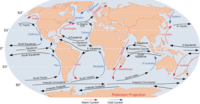
Photo from wikipedia
Understanding of population genetics is important for the conservation and management of species and ecosystems, providing information on population structure, connectivity, and demography. Here, we review the genetic patterns and… Click to show full abstract
Understanding of population genetics is important for the conservation and management of species and ecosystems, providing information on population structure, connectivity, and demography. Here, we review the genetic patterns and processes that shape the natural populations of marine organisms in Cuba, including penaeid shrimps, reef fishes, marine turtles, and bottlenose dolphins. Investigations performed over the last 20 yrs indicate three general patterns of population structure across the Cuban coast: a north-south break, an east-west split in the south, and local genetic differentiation. These patterns have been shaped by factors that include the size of the island, current patterns, lack of suitable habitats for reproduction, larval recruitment, and foraging behaviors. No single trait can predict dispersal and population structure across these diverse groups, but in every case, there are key life-history features that guide connectivity. These include limited larval dispersal in damselfishes and shrimps, social structure in dolphins, and natal homing in marine turtles. Population genetic partitions can reveal the boundaries of isolated ecosystems, guiding the design of marine protected areas.
Journal Title: Bulletin of Marine Science
Year Published: 2017
Link to full text (if available)
Share on Social Media: Sign Up to like & get
recommendations!